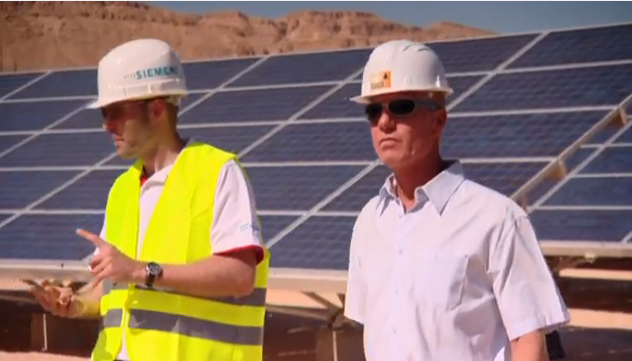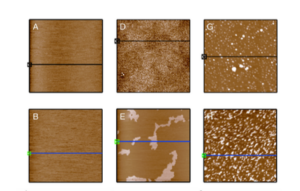Victoire pour l’industrie solaire en Israël : des projets dans le Néguev approuvés par le gouvernement

[:fr]C’est une véritable victoire pour l’industrie solaire israélienne, après deux ans d’attente, le Cabinet ministériel approuve enfin l’augmentation des quotas de puissance pour l’électricité produite à partir de panneaux photovoltaïques. Les producteurs d’énergie solaire photovoltaïque pourront atteindre les 300 MW PV.
Le gouvernement a approuvé plusieurs projets dans le désert du Néguev : 180 MW aux Kibboutz Meshabe Sade et Ze’elim. L’industrie solaire était au point mort depuis que le ministre des Finances Yaïr Lapid, en 2012, s’était fermement opposé à fournir des facilités aux producteurs d’énergie solaires de Cisjordanie, bloquant ainsi le développement de l’ensemble des projets d’énergie photovoltaïque, à l’échelle nationale. A présent, les producteurs d’énergie solaire cisjordaniens pourront convertir 30 MW PV.
Hélène Lesman.
Une centrale solaire de 40 MW, située dans le kibbutz Ketura, détenue conjointement par Siemens AG et le pionnier israélien de l’énergie solaire Arava Power , est devenue le premier pôle de production autonettoyant d’énergie solaire dans le monde. Chaque nuit, le parc d’une superficie de 8 hectares est nettoyé par cent robots de fabrication israélienne, qui brossent et nettoient des centaines de panneaux solaires, fabriqués par Suntech et générant 9 millions de kilowatts-heure d’électricité par an.
Une véritable percée technique, selon Eran Meller, directeur général d’Ecoppia , l’entreprise à l’origine de la construction du robot nettoyant. Cette avancée pourrait encourager l’utilisation d’énergie solaire. La plupart des parcs solaires se trouvent dans les déserts, à l’instar du kibbutz Ketura situé dans le sud du désert d’Arava. Avantage : le soleil y est fort, et les espaces grands ouverts. Des facteurs non négligeables à prendre en considération lors de la construction d’un parc solaire, qui compte des centaines ou des milliers de panneaux solaires.
Le désert présente quelques inconvénients, dont une énorme quantité de poussière qui se dépose sur les panneaux solaires et réduit par la même occasion l’efficacité de ces panneaux de près de 35 %, explique Meller. Pour procéder au nettoyage, les gestionnaires du parc doivent utiliser de l’eau, une denrée très rare dans le désert. En raison du coût du nettoyage traditionnel à l’eau, les panneaux solaires de Ketura étaient nettoyés environ neuf fois par an.
Au lieu d’utiliser de l’eau pour le nettoyage des panneaux, ces robots sont équipés de microfibres. Et chaque robot est affecté à une rangée de panneaux photovoltaïques. Grâce à un flux d’air contrôlé, les robots repoussent la saleté accumulée hors des panneaux. Chaque robot peut couvrir environ 100 pieds carrés de panneau par minute, ce qui représente une économie d’eau et de temps considérable. Le système de contrôle des robots est centralisé. Ils peuvent aussi fonctionner en tandem (départ et arrivée au même moment) ou de manière autonome, sur la base des instructions données par le personnel de la centrale.
La solution proposée par Ecoppia reste la mieux adaptée pour répondre aux besoins du parc solaire de Ketura, selon le PDG d’Arava Power, Jon Cohen. “Nous avons mené des recherches approfondies dans le monde entier pour trouver une solution de nettoyage qui pourrait répondre aux défis posés par des conditions météorologiques difficiles dans notre parc solaire”, a déclaré Cohen.
“Seule la solution Ecoppia permet une hausse significative de la production, tout en offrant un business model très attrayant.” Fondée en 2013, Ecoppia a trouvé preneurs dans le monde entier pour son robot nettoyant. Le seul et l’unique sur le marché, affirme fièrement l’entreprise.
Norbert Lipszyc
Source: http://www.econostrum.info/Montee-en-puissance-du-solaire-photovoltaique-israelien_a19205.html#ixzz3HbqKFfmC
Source : Israel Valley[:en]Israel’s electricity market regulator PUA surprised everyone on Tuesday by suggesting a feed-in tariff for the Timna solar park lower than initially agreed. Israel has decided to develop its PV sector further and is attempting to do so at the lowest cost possible, testing the industry.
At a hearing that took place in Israel on Tuesday, the Public Utilities Authority (PUA), the country’s electricity market regulator, clearly attempted to test the limits of the local PV industry by suggesting a feed-in tariff (FIT) for the 50 MW Timna solar park at 36 agorot (€0.07) per kilowatt hour for 20 years.
Israel’s Eilat-Eilot Renewable Energy Initiative had announced the tender for the Timna solar park in September. Speaking to pv magazine at the time, Dorit Davidovich-Banet, CEO of the Eilat-Eilot Renewable Energy Initiative, said that the tender winner would receive a fixed price per generated kilowatt hour (kWh), which had already been determined by the PUA at about 50 agorot/kWh (€0.11/kWh).
Eitan Parnass, general director of the Green Energy Association, told pv magazine that the hearing would be be finalized by November 6. He added, however, « Israel’s regulators are trying to find the right formula to allow new projects while minimizing the burden on national electricity bill. The Timna tariff hearing is an aggressive test to see how low they can go. »
Israel runs a complex system of subsidies for solar PV that currently includes a feed-in tariff model, land tenders and net metering. The Timna tender belongs to the land tenders category, according to which winners are decided by the highest bid to the Israeli Land Authority per dunam (1,000 square meters) of land. The winner receives the right to install a PV system and sell the generated electricity to the grid in a fixed tariff set by PUA.
Photovoltaic developers will need to take into account the new FIT when finally decided on November 6 to decide their bids to the Israeli Land Authority later in the year.
Previous examples of land tenders included a FIT at around €0.20 per kWh.
PUA thinks that 36 agorot per kWh is good enough for achieving a 10% investment rate of return for the Timna project, local PV market representatives told pv magazine. However, this will also depend on the bid price for the land, they added.
Last week, Israel’s government also decided to divert some 520 MW of quotas of various renewable energy types to solar PV. It appears that the Israeli government has decided to expand its photovoltaic sector beyond the 500 MW of solar PV currently installed in the country. But it also wants to do so at the lowest cost possible.
Should the new Timna tariff becomes finalized at €0.07 per kWh, this would actually mean that electricity generated from solar PV in Israel have reached grid parity prices. The average cost of grid electricity in Israel is currently about $0.12 per kWh.
It also means that solar energy in the Mediterranean region is common sense. Last year, a solar auction in Cyprus led to similarly low tariffs and the parks have already been developed. Mediterranean governments should rather learn a few lessons from Israel and Cyprus.
Readers who would like to learn more about Israel’s complex subsidy schemes and energy policy can find a detailed analysis in the September issue of pv magazine. PV in Israel will also be a topic at the upcoming Forum Solarpraxis in Berlin. Honi Kabalo, a top official at Israel’s Public Utilities Authority, will attend the conference.
[:]







